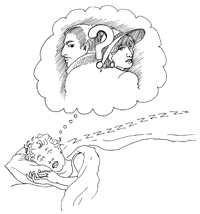STRANGE BUT TRUE- Dream strangers: They say a lot about you

DRAWING BY DEBORAH DERR McCLINTOCK
Q. Who on Earth are those complete strangers that keep making their way into my dreams? I never saw these people before. Where do they come from? –S. Freud
A. Dream images come from your personal experiences filed in long-term memory, either people you know or have seen in a movie or photograph or just imagined, says psychologist Rosalind Cartwright. The interesting issue is why you see them on any particular night. They are triggered by some emotional response to an experience during the day that you may not even be aware of consciously.
Your dream strangers are never there just by coincidence, adds psychologist Gayle Delaney, author of In Your Dreams. To figure out what they mean, ask yourself: What does the stranger look like, what is he or she wearing and doing and thinking and feeling in the context of the action of your dream. Write down four or five adjectives to describe his or her personality, then ask if there is someone, some part of yourself or something in your life that is like this figure. You may be surprised at how familiar that unknown stranger really is.
Q. How is your happiness level influenced more than you know by people you don't even know? It's the same with whether you drink, are overweight, vote or don't, and so on. –M. Zuckerberg
A. Research by Harvard medical sociologist Nicholas Christakis suggests our moods and behaviors are far more strongly influenced by those around us than we tend to think, says Michael Bond in New Scientist magazine. And it's not just our friends, but friends of our friends, and friends of friends of friends– "people three degrees of separation from us whom we have never met but whose disposition can pass through our social network like a virus."
Check out the burgeoning numbers for this "social contagion": If you have 10 friends, and each of them has 10 friends, and so on, that's 10 x 10 x 10 ... or thousands of people before you know it. Even more, it's becoming clear that a whole range of things is transmitted through this social network in ways not entirely understood: not just happiness but depression, obesity, drinking and smoking habits, tastes in music or foods, even the inclination to vote in elections. So remember the new adage: "We are who we hang out with."
Q. Some ants are farmers (cultivating fungus) and others are herders ("milking" aphids). But do any of them obey right-of-way traffic rules? –T. Longo
A. Carnivorous army ants of Central and South America stage colossal "swarm raids" in search of prey, killing as many as 30,000 animals per raid. Up to 200,000 near-blind ants stream out of their nest and form multiple freeway-like trails up to 20 meters wide (65 feet) and 100 meters long (330 feet). These are marked by smelly chemicals, or pheromones, that the ants follow. Since outbound and inbound ants both follow the same trail, massive gridlock can occur.
But research by Princeton biologist Iain Couzin and his University of Bristol colleague Nigel Franks (in Science and National Geographic News) reveals that the ants avoid congestion by obeying a simple rule: inbound ants move along the center of the pheromone trail while outbound ones follow the outer edges. Inbound ants, laden with food, are less willing to turn to avoid oncoming traffic than are their unencumbered outbound brethren. The result is an efficient traffic-flow solution.
Q. What do the ancient Greek mathematicians Pythagoras and Euclid have in common with the 20th U.S. President James A. Garfield (1831-1881)? –A. Onasis
A. All three derived original proofs of the "Pythagorean theorem," which states that for a right triangle ABC, side A squared + side B squared = side C squared (the hypotenuse).
Pythagoras and Euclid are no surprise, but Garfield? He never studied geometry formally, says Alfred S. Posamentier in Math Charmers, but while in the U.S. House of Representatives he stumbled upon a clever proof of the famous theorem, that landed in The New England Journal of Education. Today there are more than 400 proofs, many ingenious, many cumbersome, but all gaining their discoverers at least a footnote in math history.
~
Send Strange questions to brothers Bill and Rich at [email protected].
#